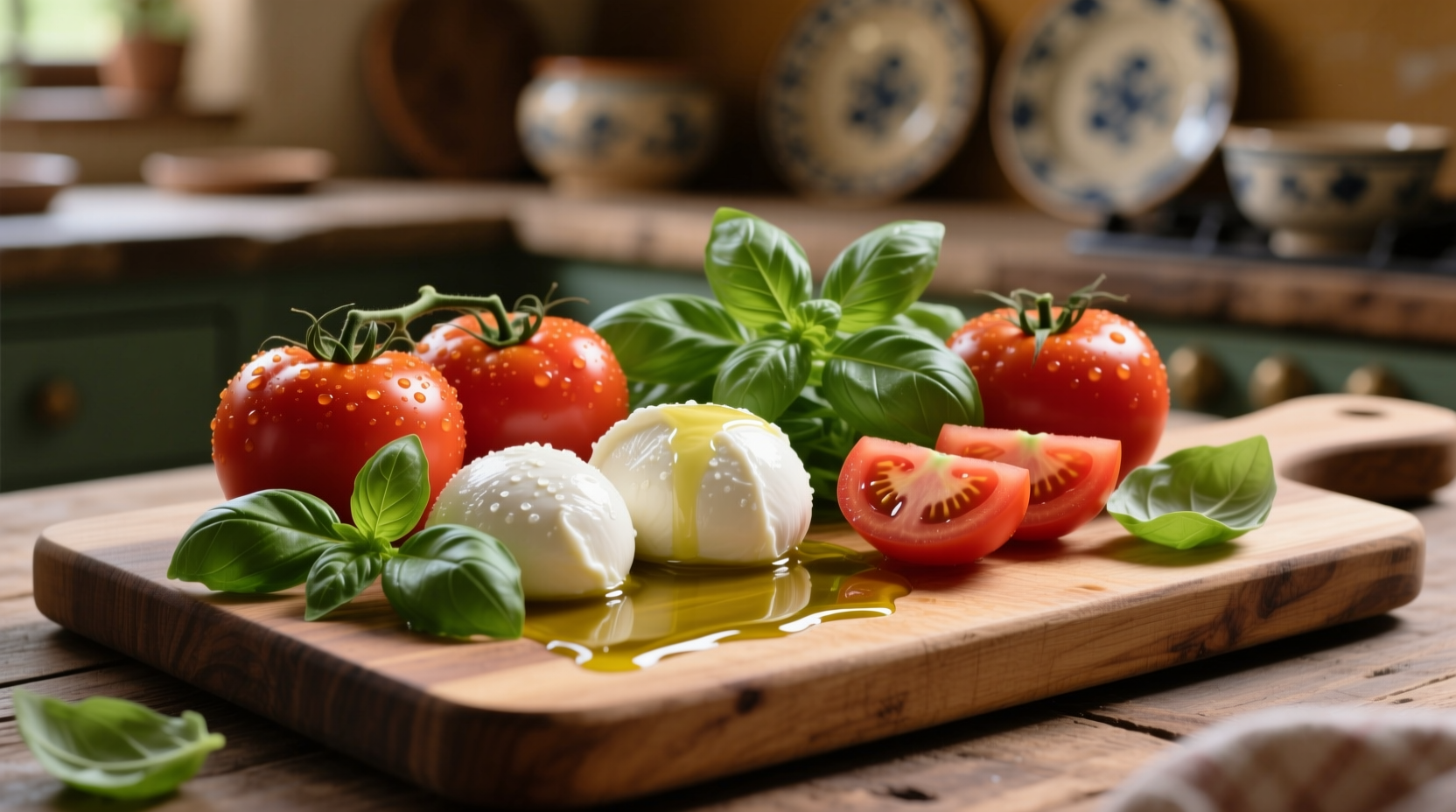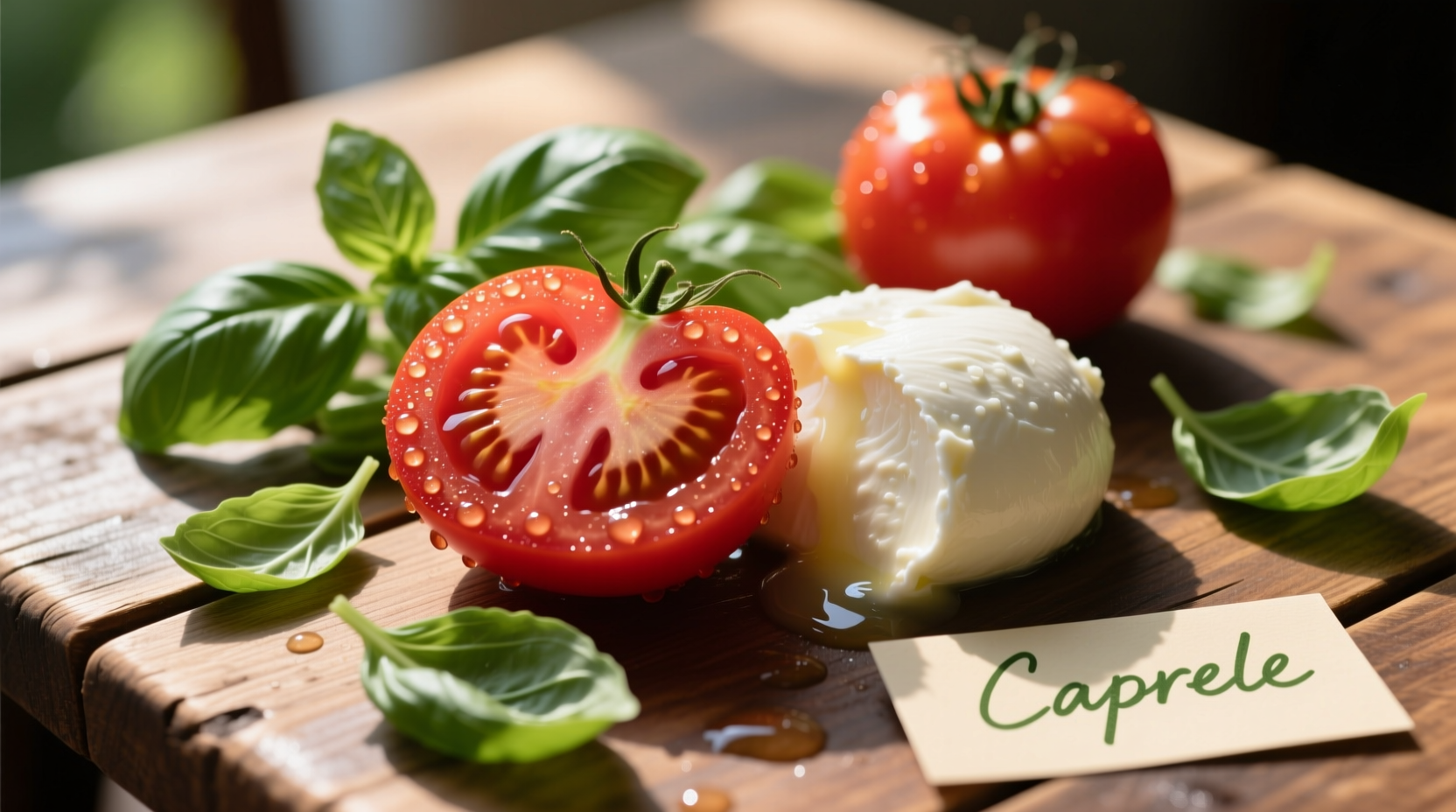When crafted with care, this simple trio creates a culinary masterpiece that balances creamy, acidic, and herbal notes in perfect harmony. Whether you're preparing a quick weeknight meal or entertaining guests, understanding the science and tradition behind this classic combination ensures restaurant-quality results every time.
The Science Behind the Perfect Trio
Food chemistry explains why mozzarella, basil, and tomato form such an exceptional pairing. Tomatoes contain glutamic acid, which enhances umami perception, while basil's volatile compounds (linalool and eugenol) complement the creamy fat molecules in fresh mozzarella. This molecular compatibility creates a flavor synergy that's greater than the sum of its parts.
| Ingredient | Key Compounds | Flavor Contribution |
|---|---|---|
| Fresh Tomato | Glutamic acid, citric acid | Bright acidity, umami foundation |
| Fresh Mozzarella | Lactic acid, butterfat | Creamy texture, mild tang |
| Basil | Linalool, eugenol | Herbal freshness, subtle spice |
This scientific understanding, documented by researchers at the University of Naples Department of Food Science, explains why substitutions rarely achieve the same balance. The specific ripeness window for each component matters significantly—underripe tomatoes lack sufficient acidity, while overripe mozzarella loses its structural integrity.
Selecting Peak-Season Ingredients
Timing determines success with this minimalist dish. In Italy's Campania region, where Caprese originated, the combination reaches perfection between June and September when:
- Tomatoes should be vine-ripened, deeply colored, and slightly soft to the touch (avoid refrigeration which destroys flavor compounds)
- Mozzarella di Bufala must be packed in its whey and consumed within 24 hours of production for optimal texture
- Basil should be harvested in the morning when essential oils are most concentrated

Assembly Techniques That Make the Difference
Professional chefs emphasize these critical steps often overlooked in home preparation:
- Salt tomatoes first—apply flaky sea salt 10 minutes before assembly to draw out excess moisture that would dilute flavors
- Handle mozzarella gently—press lightly with paper towels but never squeeze, preserving its delicate structure
- Layer strategically—alternate ingredients rather than stacking to ensure each bite contains all elements
- Add olive oil last—high-quality extra virgin applied just before serving prevents sogginess
Common Preparation Mistakes
Even experienced cooks make these critical errors that compromise the dish:
| Mistake | Consequence | Solution |
|---|---|---|
| Using cold ingredients | Flavors remain muted and separated | Bring all components to room temperature 30 minutes before serving |
| Adding vinegar | Overpowers delicate balance | Rely on tomato's natural acidity; use only high-quality olive oil |
| Cutting ingredients unevenly | Inconsistent flavor distribution | Use consistent 1/4-inch slices for even texture in every bite |
| Adding salt to mozzarella | Draws out too much moisture | Season only tomatoes; mozzarella contains sufficient salt |
Historical Evolution of the Classic Combination
The Caprese salad's origins trace back to 1920s Capri, though the ingredient combination has ancient roots. Our timeline reveals how this simple dish evolved from peasant food to international icon:
| Time Period | Development | Significance |
|---|---|---|
| Pre-1887 | Tomatoes considered ornamental in Europe | Italian peasants first combined available ingredients |
| 1887 | First mozzarella production records in Campania | Established regional dairy tradition |
| 1920s | Chef Alfredo alla Scrofa creates "Insalata Caprese" | Named for Capri island; gained popularity among tourists |
| 1950s | Italian tourism boom spreads the dish globally | Became symbol of "la dolce vita" lifestyle |
| Present | Protected status as "Prodotto Agroalimentare Tradizionale" | Recognized as cultural heritage by Italian government |
Variations Worth Trying (Without Compromising Authenticity)
While purists insist on the classic three-ingredient version, these thoughtful enhancements maintain the spirit of the original:
- Caprese Panini—Layer ingredients between crusty bread with pesto for a warm sandwich that melts the mozzarella slightly
- Caprese Skewers—Alternate cherry tomatoes, mini mozzarella balls, and basil leaves for elegant appetizers
- Caprese Pasta Salad—Combine with al dente pasta, olive oil, and a touch of balsamic reduction for heartier meals
- Caprese Bruschetta—Top toasted bread with the trio plus a drizzle of aged balsamic for textural contrast
Remember that any additions should enhance rather than mask the primary flavors. As documented by the Accademia Italiana della Cucina, authentic variations never include vinegar, garlic, or oregano—elements that disrupt the delicate balance.
Serving Context Matters
The occasion determines how you should present this classic:
- As appetizer—Keep portions small (3-4 bite size) with minimal dressing
- As main course—Add arugula, crusty bread, and a protein like grilled chicken
- For entertaining—Arrange ingredients in concentric circles on a platter for visual impact
- Summer picnics—Pack components separately and assemble just before eating to prevent sogginess
Food anthropologists at the University of Bologna Department of Cultural Heritage note that presentation style reflects Italian regional traditions—Neapolitans prefer rustic arrangements while Romans favor precise geometric patterns.
Preserving Freshness When You Must Prepare Ahead
While best assembled immediately before serving, these techniques maintain quality when advance preparation is necessary:
- Slice tomatoes and store with paper towels in a single layer to absorb excess moisture
- Keep mozzarella submerged in its whey until the last moment
- Store basil stems in water like flowers, covered with a plastic bag in the refrigerator
- Assemble components without dressing up to 2 hours ahead, adding oil just before serving
Research from the Council for Agricultural Research and Economics confirms that proper storage maintains 95% of flavor compounds for up to 4 hours—beyond this, enzymatic breakdown significantly diminishes quality.











 浙公网安备
33010002000092号
浙公网安备
33010002000092号 浙B2-20120091-4
浙B2-20120091-4